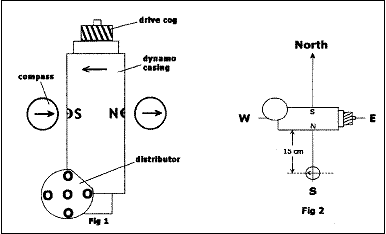Unlike alternators, A7 dynamos need residual magnetism to start generating. “Residual Magnetism” however, is an elusive and variable thing. You can check your dynamo’s residual/permanent magnetism and check whether it’s the correct polarity. The following discussion applies to 2 pole dynamos, first used in the A7 in 1932. Earlier cars used 4 pole dynamos but the same principles apply to both varieties.

Looking at the body of a Lucas 35A or C35M dynamo, you will find two large screws on opposite sides —see Figure 1. These hold the pole pieces of the field magnets in position and are approximately at the centre of the magnets. The pole pieces are weak permanent magnets whose magnetism is reinforced once the dynamo starts to generate. If your car is wired with a negative earth (the lead from the negative pole of the battery being connected directly to the chassis) then the south pole of a compass needle will point to the right hand side field coil screw as shown in Figure 1. The north pole of the needle will point to the left hand side field coil screw (viewed looking down upon the dynamo). This means the internal field within the dynamo, due to the field poles, i.e. from right to left (by convention, magnetic lines of force are taken to flow from the North Pole to the South Pole. The direction of the magnetic field is from left to right if your dynamo is set up for a positive earth arrangement, so the compass needle directions will be opposite those in figure 1. If the compass directions are “at odds” with the above, then you have problems. For example, if the two field coils are connected wrongly within the body of the dynamo, it is possible to have both pole pieces with north poles, or both with south poles, or both with south coils. The dynamo will never work and no amount of trying to reset the field coils’ polarity by “flashing” current through then will help.
Confusion can arise if you should make the test while the dynamo is actually generating. The north pole will appear to an external compass to be a south pole, but a compass within the dynamo would show it is actually still a north pole. Once the engine is switched off, the “external polarity” of the field pole will by found to revert to what it was original (i.e. a north pole.)
It is theoretically possible for the pole pieces to completely lose their permanent magnetism (the word “permanent” being somewhat of a misnomer.) In this case, each field pole would attract both the north and the south poles of the compass needle—the compass needle is only a magnet and a magnet will be attracted to any ferrous material regardless of which pole of the magnet is used. But in practice a compass is such a sensitive instrument, that you will be hard-pressed to pick up some magnetism and effectively become a weak permanent magnet. This magnetism is induced by the Earth’s magnetic field. One might philosophise as to whether all this incidental magnetism of civilisations iron and steel objects has in some way depleted the strength of the Earth’s magnetism!! If you do find a non-magnetised steel artefact, it’ll probably be a grade of stainless steel which cannot be magnetised!
Your dynamo is likely to show some level of permanent magnetism when tested with a compass—but HOW do you decide when it’s enough? This question will be of particular interest to members who rely on the dangerous practice of pushing the dynamo cut-out down in order to start the dynamo generating after standing for a while. Is there a maximum level and can one ‘beef up’ one’s dynamo to ensure more reliable ‘winding up” of the generation process?
Remove the dynamo from the car and wander off with it —up the garden, perhaps, to somewhere where there is no overhanging garage door or other ferrous metal object. Find the North by use of a compass and make a line on the ground, running from North to South. Lay the dynamo so its longitudinal axis is a right angle to the North-South line. If your dynamo is polarised for negative earth operation, then lay the dynamos as in Fig 2, with the drive cog facing East. Starting some distance away, bring the compass towards the field coil’s screw, (which is acting as a North Pole.) The compass needle will initially point towards the North, but as it comes under the influence of the dynamo’s field coil it will start to rotate. If you move it right up to the coil, the needle will swing through 180 degrees, so the needle’s south pole is firmly gripped by the residual north pole of the field magnet. You will find that there is an intermediate position, where the dynamo’s field and the Earth’s magnetic field exactly cancel each other out. The needle will then lie East to West, as in Fig.2. This behaviour is well defined (i.e. is reproducible), and balance occurs at a distance of 15 centimetres (measured to the dynamo housing, not its centre line) for a well polarised Lucas C35M dynamo. One gets the same results with different compasses, so the result is not “compass specific.”
Some of you may have noticed that the compass needle was originally attracted to the Earth’s Magnetic North and was then moved towards the dynamo’s North pole field coil. So, why should the needle rotate through 180 degrees? The answer is “When a compass is pointing to the Earth’s North Pole, it is actually pointing towards whet is effectively the South Pole of an enormous magnet located at the North Pole. I.e. UNLIKE POLES ATTRACT, WHILST LIKE POLES REPEL.”
Mike Sharp